Bicol Express Recipe is a fiery and flavorful dish hailing from the Bicol region of the Philippines. This iconic dish is known for its intense heat, derived from the generous use of chili peppers, and its rich, savory broth that’s infused with coconut milk and pork.
The history of Bicol Express dates back centuries, evolving alongside the culinary traditions of the Bicol region. It’s a dish that embodies the vibrant flavors and passionate spirit of the Bicolanos.
The key to a truly authentic Bicol Express lies in the quality of its ingredients. Fresh chili peppers, like the fiery siling labuyo, are essential for achieving the desired level of heat. Tender pork, slow-cooked in a rich coconut milk broth, provides a satisfying base for the dish.
The addition of garlic, onions, and ginger adds depth and complexity to the flavor profile, while a touch of fish sauce lends a savory umami note.
Bicol Express
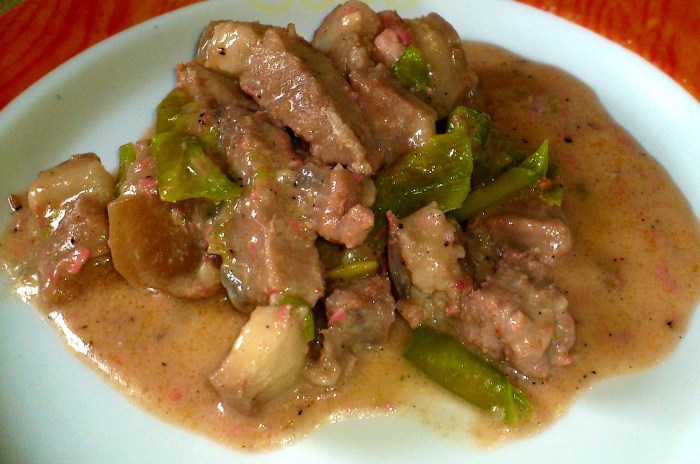
Bicol Express, a fiery and flavorful dish, is a beloved staple in Filipino cuisine, particularly in the Bicol region. This iconic dish embodies the rich culinary heritage of the region, showcasing the bold use of chili peppers and coconut milk.
The History and Origins of Bicol Express
Bicol Express traces its roots back to the Bicol region, a southeastern province of the Philippines known for its volcanic terrain and abundant agricultural produce. The dish’s origins are intertwined with the local culture and way of life, where chili peppers, a staple ingredient, are readily available and deeply ingrained in the regional cuisine.
The exact origins of Bicol Express are unclear, but it is believed to have evolved from a simple dish of pork and chili peppers cooked in coconut milk. Over time, the recipe was refined and adapted, incorporating other ingredients like onions, garlic, and shrimp paste, resulting in the vibrant and flavorful dish we know today.
The Cultural Significance of Bicol Express in the Bicol Region
Bicol Express holds a special place in the hearts and kitchens of Bicolanos, representing more than just a culinary delight. The dish is a symbol of the region’s unique identity and culinary prowess. Its fiery nature reflects the Bicolano’s resilience and passion, while its rich flavors represent the abundance and fertility of the land.
Bicol Express is a dish that is often served during special occasions and celebrations, bringing families and communities together. It is also a popular street food, enjoyed by locals and tourists alike.
The Evolution of the Bicol Express Recipe Over Time
The Bicol Express recipe has undergone a gradual evolution over the years, with different variations emerging to suit individual preferences and culinary trends. While the core ingredients remain the same, the level of spiciness, the use of different types of chili peppers, and the addition of other ingredients like seafood or vegetables have all contributed to the diversity of Bicol Express recipes.
“The beauty of Bicol Express lies in its versatility. It can be customized to suit different palates, making it a truly personal dish.”
Key Ingredients and Their Roles
Bicol Express is a vibrant and flavorful dish that gets its unique character from a combination of key ingredients. Each component plays a crucial role in shaping the dish’s signature spicy, savory, and slightly sweet taste.The success of Bicol Express hinges on the quality and freshness of its ingredients.
Do not overlook explore the latest data about ham gravy recipe.
Using fresh, high-quality ingredients ensures the dish’s flavors are bright and well-defined, enhancing the overall dining experience.
Chili Peppers and Their Heat Levels
The chili peppers are the heart and soul of Bicol Express, providing the dish’s signature heat. The type of chili pepper used significantly impacts the dish’s overall spiciness.
The most common chili peppers used in Bicol Express are sili labuyoand sili guinataang.
- Sili labuyois known for its intense heat and bright red color. It delivers a sharp, fiery kick that is characteristic of Bicol Express.
- Sili guinataang, also known as bird’s eye chili, is another popular choice. It offers a slightly milder heat than sili labuyo, but still packs a punch. Its flavor is often described as slightly fruity and tangy.
The amount of chili pepper used can be adjusted based on personal preference. For those who prefer a milder experience, using fewer chili peppers or opting for a less spicy variety can be considered.
Pork and its Role in Flavor
Pork is a staple ingredient in Bicol Express, contributing a rich, savory flavor that balances the chili peppers’ heat. The pork is typically sliced or diced and cooked until tender and flavorful.
- Pork bellyis a popular choice, as its fat content adds richness and depth to the dish.
- Pork shoulderis another option, providing a leaner and more robust flavor.
The pork is often cooked in coconut milk, which further enhances its flavor and creates a creamy texture.
Coconut Milk and its Contribution to Texture
Coconut milk is a crucial ingredient in Bicol Express, providing a creamy texture and a subtle sweetness that balances the dish’s spiciness.
- Full-fat coconut milkis preferred for its rich flavor and creamy texture.
- Light coconut milkcan be used as an alternative, but it may result in a less creamy texture.
Coconut milk also helps to mellow the chili peppers’ heat, creating a more balanced flavor profile.
Other Essential Ingredients, Bicol express recipe
Other essential ingredients that contribute to Bicol Express’s unique flavor profile include:
- Garlic and onions:These aromatics add a savory depth and fragrance to the dish.
- Fish sauce:A small amount of fish sauce is often used to enhance the dish’s savory flavor.
- Salt and pepper:These seasonings are used to adjust the dish’s saltiness and spice levels.
Variations and Regional Differences: Bicol Express Recipe
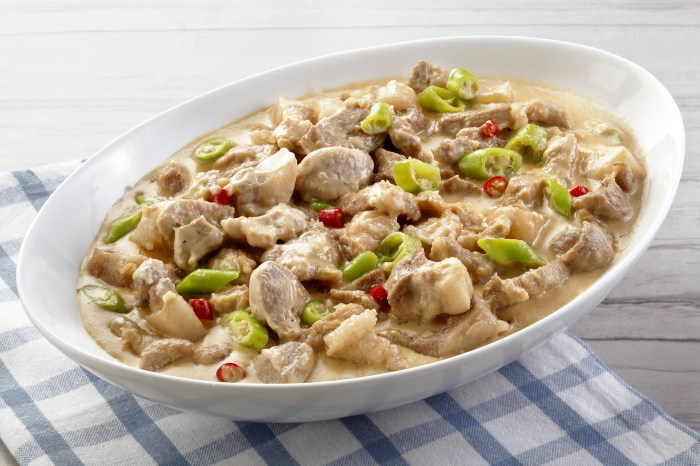
While the Bicol Express recipe is generally known for its fiery heat and savory flavor, regional variations exist across the Philippines, adding unique twists to this beloved dish. These variations often reflect local culinary traditions and the availability of ingredients.
Variations in Meat
The type of meat used in Bicol Express can significantly impact its flavor profile. While pork is the most common choice, other options like chicken, seafood, or even a combination of meats are frequently used.
- Pork:The most traditional choice, pork provides a rich, savory flavor and a satisfyingly tender texture. It’s often used in the form of belly, shoulder, or even ground pork, contributing to the dish’s overall richness.
- Chicken:Offering a lighter, leaner alternative, chicken adds a delicate flavor to Bicol Express. It’s often used in the form of boneless, skinless chicken breasts or thighs, providing a tender and juicy texture.
- Seafood:In coastal regions, Bicol Express often features seafood like shrimp, squid, or fish. Seafood adds a briny and slightly sweet flavor to the dish, complementing the spiciness of the chili peppers. This variation is particularly popular in areas with abundant seafood resources.
Regional Ingredients and Techniques
The unique flavors of Bicol Express are also influenced by the use of regional ingredients and techniques.
- Gata (Coconut Milk):In some regions, gata (coconut milk) is used to add a creamy and slightly sweet dimension to the dish. This variation is particularly common in areas where coconut is readily available.
- Local Chili Peppers:Different regions in the Philippines have their own unique varieties of chili peppers. The choice of chili peppers, such as the fiery siling labuyo or the milder siling haba, can significantly affect the spiciness of Bicol Express. This creates a diverse range of heat levels depending on the region.
- Regional Spices and Herbs:Some regions incorporate local spices and herbs into their Bicol Express recipes. These additions can provide a complex depth of flavor, enhancing the overall taste experience. For example, some regions might use turmeric, ginger, or lemongrass to add a unique aromatic twist.
Cooking Techniques and Tips
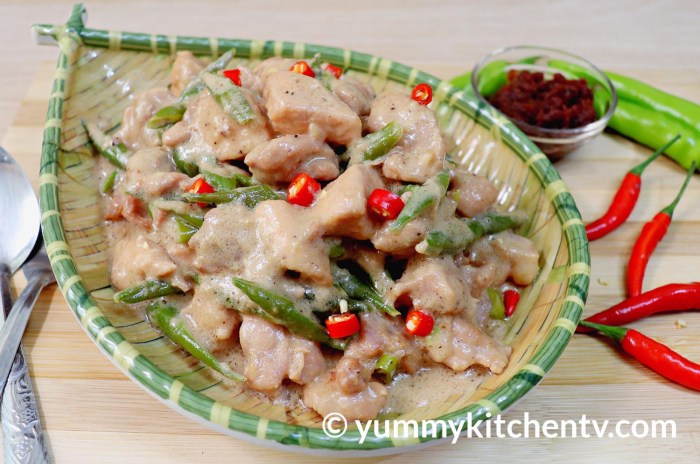
Mastering the art of Bicol Express cooking involves understanding the interplay of heat, sweetness, and savory flavors. This dish thrives on a balance of these elements, requiring careful attention to cooking techniques to achieve the desired outcome.
Sautéing and Simmering
Sautéing plays a crucial role in developing the flavors of the ingredients, especially the pork or shrimp. The high heat allows for quick browning, which adds depth and richness to the dish. Simmering, on the other hand, allows the flavors to meld together, creating a harmonious blend.
- Sauté the pork or shrimp over medium-high heat until browned on all sides. This step extracts the natural fats and adds a delicious savory note to the dish.
- Simmer the Bicol Express for 15-20 minutes, allowing the flavors to develop and the chili peppers to release their heat.
Balancing Heat, Sweetness, and Savory Flavors
Achieving the perfect balance of heat, sweetness, and savory flavors is key to a truly satisfying Bicol Express.
- Adjust the amount of chili peppers to your desired level of spiciness. Remember that the heat of chili peppers can vary, so start with a smaller amount and add more if needed.
- The sweetness in Bicol Express comes from the coconut milk. Use full-fat coconut milk for a richer, creamier flavor.
- The savory flavor comes from the pork or shrimp, as well as the soy sauce and fish sauce. Use high-quality soy sauce and fish sauce for the best results.
Adjusting Heat Levels
Controlling the heat level is essential to prevent burning the ingredients.
- Use medium-high heat for sautéing to ensure quick browning without burning.
- Reduce the heat to low or medium-low for simmering, allowing the flavors to develop without scorching the ingredients.
- Monitor the heat throughout the cooking process and adjust as needed to prevent burning.
Serving Suggestions and Pairings
Bicol Express, with its fiery flavors and rich textures, is a dish that begs to be enjoyed in a variety of ways. It can be a hearty main course, a flavorful side dish, or even a topping for other dishes.
Here are some suggestions for serving and pairing Bicol Express for a truly satisfying culinary experience.
Traditional Serving
Bicol Express is traditionally served hot, often with a side of steamed rice to absorb the spicy sauce. It is also commonly paired with other Filipino dishes, such as:
- Sinigang: A sour and savory soup, provides a refreshing contrast to the spicy Bicol Express.
- Adobo: A classic Filipino dish, the savory and tangy flavors of adobo complement the spicy kick of Bicol Express.
- Lechon Kawali: Crispy pork belly, the richness of lechon kawali balances the heat of Bicol Express.
International Pairings
Bicol Express can also be paired with dishes from other cuisines, especially those with complementary flavors.
- Indian Curry: The fiery spices of Indian curry pair well with the heat of Bicol Express.
- Mexican Tacos: The spicy and savory flavors of Bicol Express can be used as a topping for tacos.
- Thai Green Curry: The fragrant and spicy flavors of Thai green curry create a delicious combination with Bicol Express.
Beverage Pairings
The spiciness of Bicol Express can be balanced by a variety of beverages. Here are some recommendations:
| Beverage | Pairing Rationale |
|---|---|
| Cold Beer | The crispness of beer helps to cool the palate and quench thirst. |
| Sweet Tea | The sweetness of tea helps to offset the spiciness of the dish. |
| Coconut Water | The natural sweetness and electrolytes of coconut water help to rehydrate and soothe the mouth. |
Bicol Express: A Culinary Icon
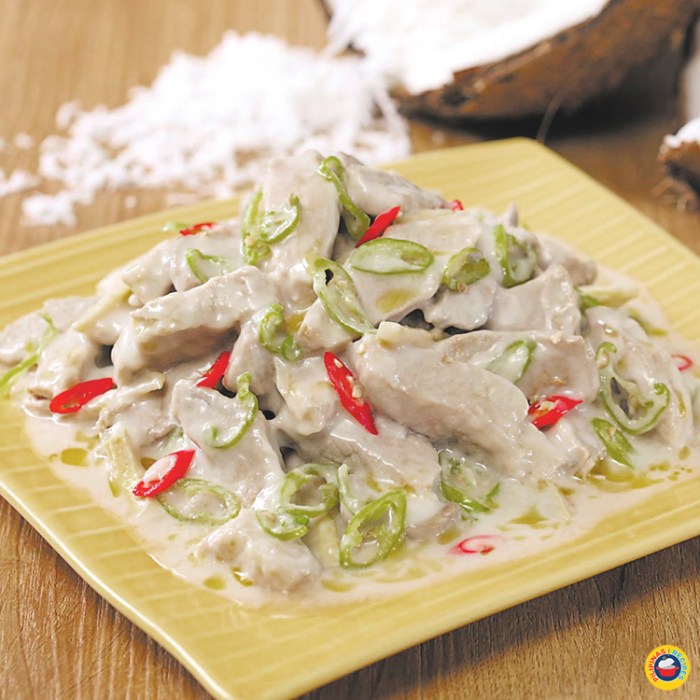
Bicol Express, with its fiery flavors and irresistible aroma, is more than just a dish; it’s a culinary icon that encapsulates the vibrant spirit of the Bicol region in the Philippines. This dish has transcended regional boundaries, becoming a beloved staple in Filipino kitchens and restaurants across the country and even gaining popularity internationally.
Cultural Impact of Bicol Express
Bicol Express is a testament to the culinary ingenuity and cultural heritage of the Bicol region. The dish’s popularity has played a significant role in promoting Bicolano cuisine and showcasing its unique flavors and ingredients. Beyond its gastronomic appeal, Bicol Express is often associated with the region’s warm hospitality and vibrant culture.
The dish has also become a symbol of Bicolano identity, representing their resilience and passion. It’s a dish that’s shared during celebrations, family gatherings, and even everyday meals, fostering a sense of community and connection.
Popularity and Role in Filipino Food Culture
Bicol Express has achieved widespread popularity throughout the Philippines, becoming a staple in Filipino food culture. Its fiery flavors and rich history have made it a beloved dish across generations. The dish’s versatility allows it to be enjoyed as a main course, side dish, or even as a topping for other dishes.The popularity of Bicol Express is evident in its widespread availability.
It’s featured on menus of restaurants, street food stalls, and even home-cooked meals. The dish’s presence in Filipino food culture is a testament to its enduring appeal and its ability to connect people through shared culinary experiences.
Visual Representation of Bicol Express
Imagine a steaming bowl of Bicol Express, its vibrant colors inviting you to take a bite. The dish features a rich, reddish-brown sauce, glistening with the oil from the pork and infused with the heat of chili peppers. Tiny green bell peppers and vibrant red chili peppers add a splash of color, while the creamy coconut milk adds a touch of richness.
The aroma of the dish is intoxicating, a blend of smoky, savory, and spicy notes that tantalizes the senses. The dish’s visual appeal is as captivating as its taste, making it a true culinary masterpiece.
Final Summary
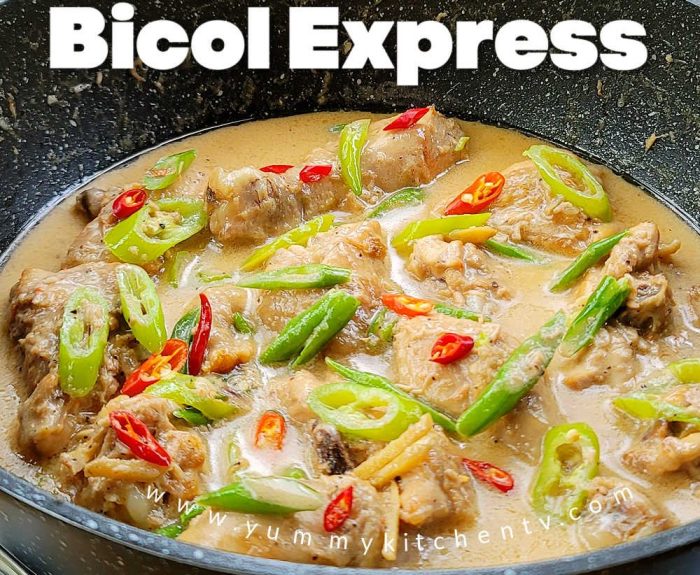
Bicol Express is more than just a recipe; it’s a cultural icon that represents the fiery spirit and culinary ingenuity of the Bicol region. Its bold flavors and vibrant colors have captivated taste buds across the Philippines and beyond. Whether you’re a seasoned chili enthusiast or a curious newcomer to Filipino cuisine, Bicol Express is an unforgettable culinary experience that will leave you wanting more.
